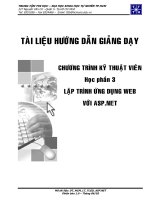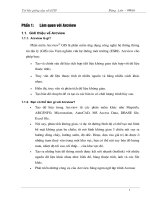Tài liệu giảng dạy CCNA - module 01 chapter 02 -The TCP IP and OSI Networking Models
Bạn đang xem bản rút gọn của tài liệu. Xem và tải ngay bản đầy đủ của tài liệu tại đây (441.15 KB, 31 trang )
1
Module 01
InterNetwork Overview
Chapter 02
The TCP/IP and OSI Networking Models
2
Table of Content
1 The TCP/IP protocol architecture
2 The OSI model.
3
1. THE TCP/IP PROTOCOL
ARCHITECTURE
4
The TCP/IP Application Layer
TCP/IP application layer protocols provide
services to the application software running
on a computer. The application layer does
not define the application itself, but rather it
defines services that applications need—like
the ability to transfer a file in the case of
HTTP. In short, the application layer
provides an interface between software
running on a computer and the network
itself.
5
The TCP/IP Application Layer (cont.)
First, the request for the file and the actual transfer of
the file are performed according to the Hypertext
Transfer Protocol (HTTP).
The other protocol used is the Hypertext Markup
Language (HTML). HTML defines how Bob’s web browser
should interpret the text inside the file he just received.
TCP/IP Network
Give me your home page
This is file home.htm
Web
server
Web
client
Larry
Bob
6
The TCP/IP Application Layer (cont.)
To get the web page from Larry, Bob sends
something called an HTTP header to Larry. This
header includes the command to “get” a file.
The response from Larry includes an HTTP header as
well, with something as simple as “OK” returned in
the header.
HTTP Header: get home.htm
HTTP Ok Contents home.htm
Web
server
Web
client
Larry
Bob
7
The TCP/IP Transport Layer
HTTP Get
HTTP GetTCP
HTTP Ok Web pageTCP
TCP Acknowledgment
TCP Acknowledgement
Please Reliably
Send
This, Mr. TCP!
Web server
Web
client
8
Summary: Same-Layer and Adjacent-Layer
Interactions
Source Destination
Physical Medium
Peer layers - PDUs
4 4
Request services
Provide services
9
The TCP/IP Internetwork Layer
IP defines logical addresses, called IP addresses, that allow each
TCP/IP speaking device (called IP hosts) to communicate.
It also defines routing—the process of how a router should
forward, or route, packets of data.
HTTP Get
HTTP GetTCP
HTTP GetTCPIP
Destination 1.1.1.1
Source 2.2.2.2
Bob 2.2.2.2
Larry 1.1.1.1
10
The TCP/IP Network Interface Layer
The network interface layer defines the
protocols and hardware required to deliver
data across some physical network. The term
network interface refers to the fact that this
layer defines how to connect the host
computer to the network; it is the interface
between the computer and the network.
The network interface layer includes a large
number of protocols: LAN standards such as
Ethernet, WAN standards such as PPP, Frame
Relay.
11
Encapsulation example: E-mail
12
2. THE OSI MODEL
13
OSI reference model development
Researched and developed by the ISO - International
Organization for Standardizations.
1977: establish a subcommittee to develop a
communications architecture.
1984: publish ISO-7498, the Open System
Interconnection (OSI) reference model.
14
OSI reference model
The OSI reference model
The OSI reference model: A framework that is used
to understand how information travels
throughout a network.
It provided vendors with a set of standards
It provided vendors with a set of standards
that ensured greater compatibility and
that ensured greater compatibility and
interoperability between the various types of
interoperability between the various types of
network technologies that were produced by
network technologies that were produced by
the many companies around the world.
the many companies around the world.
Proprietary
Proprietary
vs.
vs.
Open
Open
15
Comparing TCP/IP with OSI
16
Comparing TCP/IP with OSI (cont.)
Similarities:
Both have layers.
Both have application layers, though
they include very different services.
Both have comparable transport and
network layers.
Both models need to be known by
networking professionals.
Both assume packets are switched.
17
Comparing TCP/IP with OSI (cont.)
Differences:
TCP/IP combines the presentation and
session layer issues into its application
layer.
TCP/IP combines the OSI data link and
physical layers into the network access
layer.
TCP/IP appears simpler because it has
fewer layers.
18
Layers of OSI reference model
Layer 7: Application
Layer 6: Presentation
Layer 5: Session
Layer 4: Transport
Layer 3: Network
Layer 2: Data Link
Layer 1: Physical
19
OSI layers: layer 1
20
OSI layers: layer 2
21
OSI layers: layer 3
22
OSI layers: layer 4
23
OSI layers: layer 5
24
OSI layers: layer 6
25
OSI layers: layer 7









